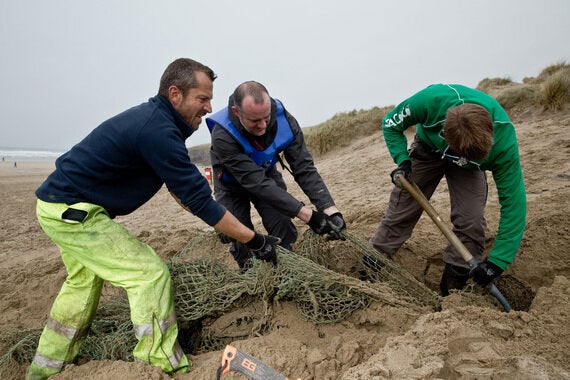Our beautiful seas and oceans cover about 70% of our planet's surface, with far more species living in the oceans than on land. The marine environment provides livelihoods and food for hundreds of millions of people, so it is important that we protect it.
Yet, right now, millions of animals, including whales, seals, turtles and birds are being mutilated and killed by 'ghost' fishing gear - nets, lines and traps that are abandoned, lost or discarded.
Of course, fishing gear is designed to capture animals, so when lost or dumped it carries on doing just that - entangling and trapping marine animals indiscriminately. For example 870 ghost nets recovered off Washington State in the U.S. had trapped more than 32,000 marine animals. These animals may have drowned within minutes, or endured long, slow deaths lasting months or even years, all the while suffering from debilitating wounds, infection and starvation.

© World Animal Protection / Rachel Ceretto
What we know is that as well as causing needless animal suffering; ghost fishing gear is also causing significant damage to marine ecosystems, compromising fisheries and threatening human life and health; from divers to those navigating the seas in boats. This has not gone unnoticed, governments and marine industries have been spending many millions of dollars annually cleaning up and repairing the damage caused by ghost gear.
The causes of ghost gear can range from bad weather, gear conflict, and accidental loss or even deliberate dumping. It is conservatively estimated that a staggering 640,000 tonnes of fishing gear ends up in our oceans each year, equivalent to dumping three million cars in the sea over the next ten years. And with fishing gear designed to last, it stays in our oceans for up to 600 years. Even when this vast bulk does begin to break down in centuries to come, it will still pose a threat as it leaves particles the size of grains of sand - known as microplastics, to contaminate our water and enter the food chain.
Its impact is also financial: ghost gear catches species without economic benefit but with economic cost; such as the loss of marketable lobster due to ghost fishing gear with an estimated global loss of US$250 million per year.
We are creating an underwater dumping ground that entangles and kills an estimated 136,000 whales seals and sea lions alone and is growing each year. This largely hidden problem needs sustainable solutions on a global scale.
That is why the Global Ghost Gear Initiative (GGGI), founded by World Animal Protection is being launched this week in London. The launch will bring together the leading experts from around the world, and is the first and only initiative to be tackling the ghost gear problem on a global scale. It will include participants from the United Nations Environment Programme, the Marine Stewardship Council, Young's seafood and Australia's Northern Prawn Fishery to name a few, and will mark the start of an action plan to ensure safer, cleaner oceans. This initiative brings real hope that these solutions can be found, with industry, governments, charities and academics all pulling together to free the oceans of ghost gear.

© World Animal Protection / Greg Martin
There is a collective responsibility to tackle this problem. Seafood retailers and brands need to take responsibility, by introducing and enforcing better policy for fishing gear management and disposal. Government authorities - local, national and international - also have a key role to play. On a local level this may be simple actions like making sure there are places where fishermen can dispose of their nets in each port; or internationally, the setting of regulations for ownership marks on fishing gear, as one way to ensure more responsible disposal.
My hope is that by uniting global efforts, we can move towards a future where ghost gear no longer poses an ever-growing threat to our oceans or the animals that live in them.

© NOAA / NMFS